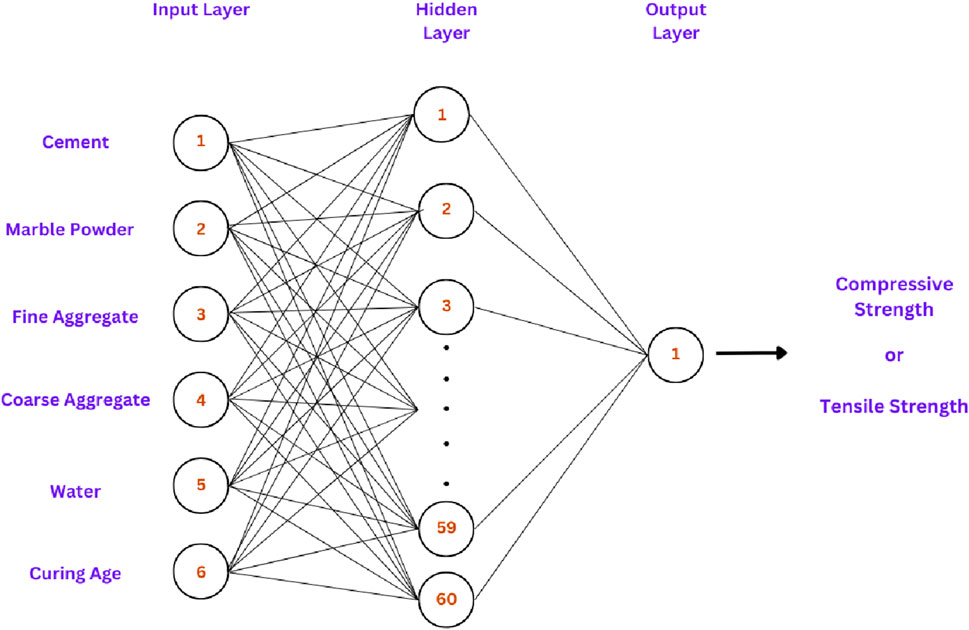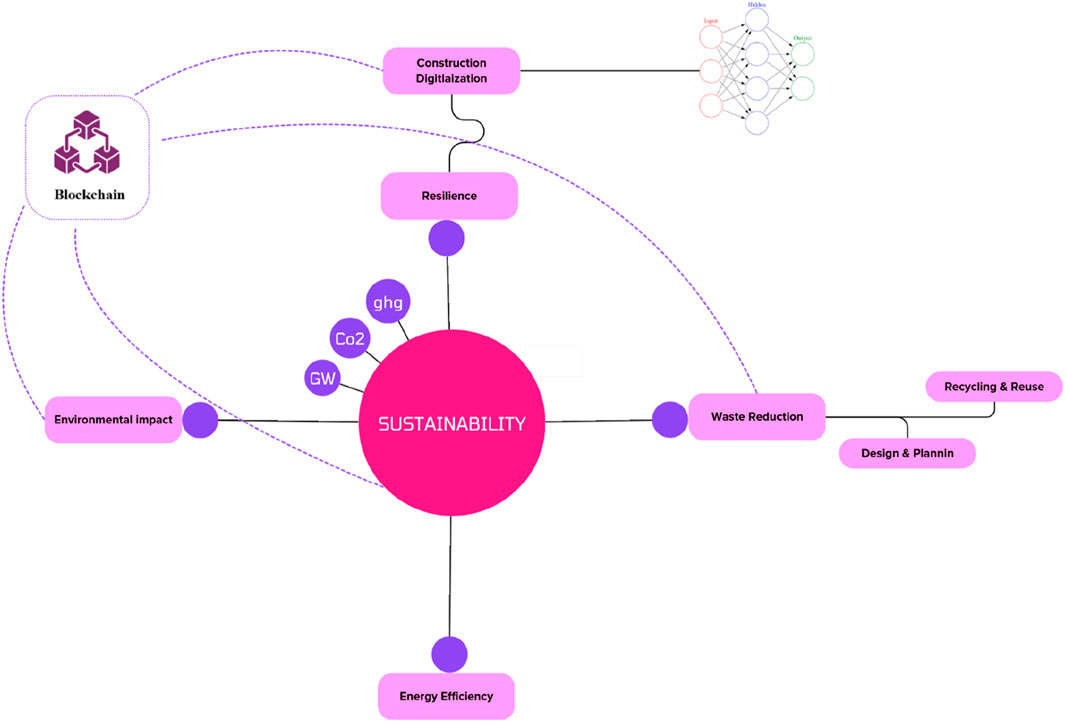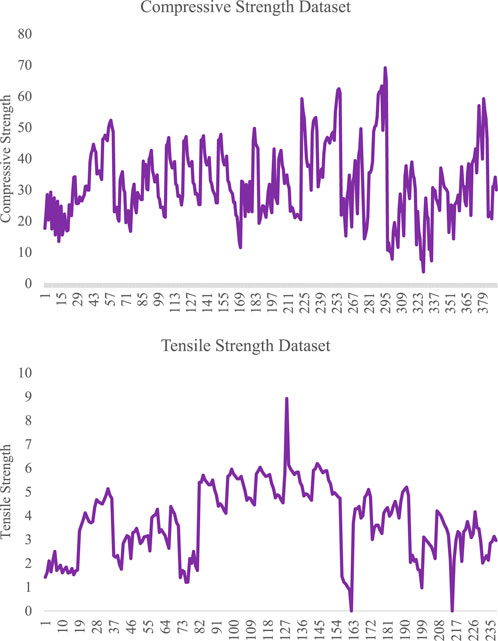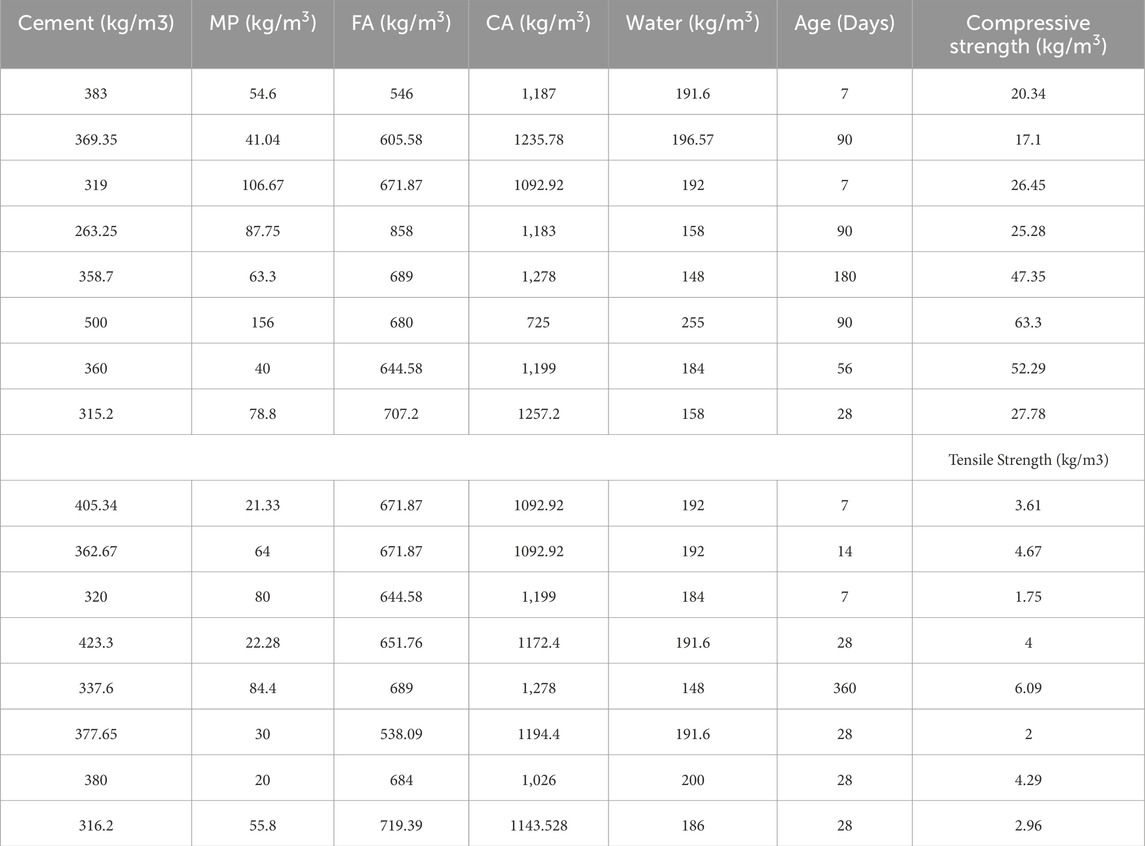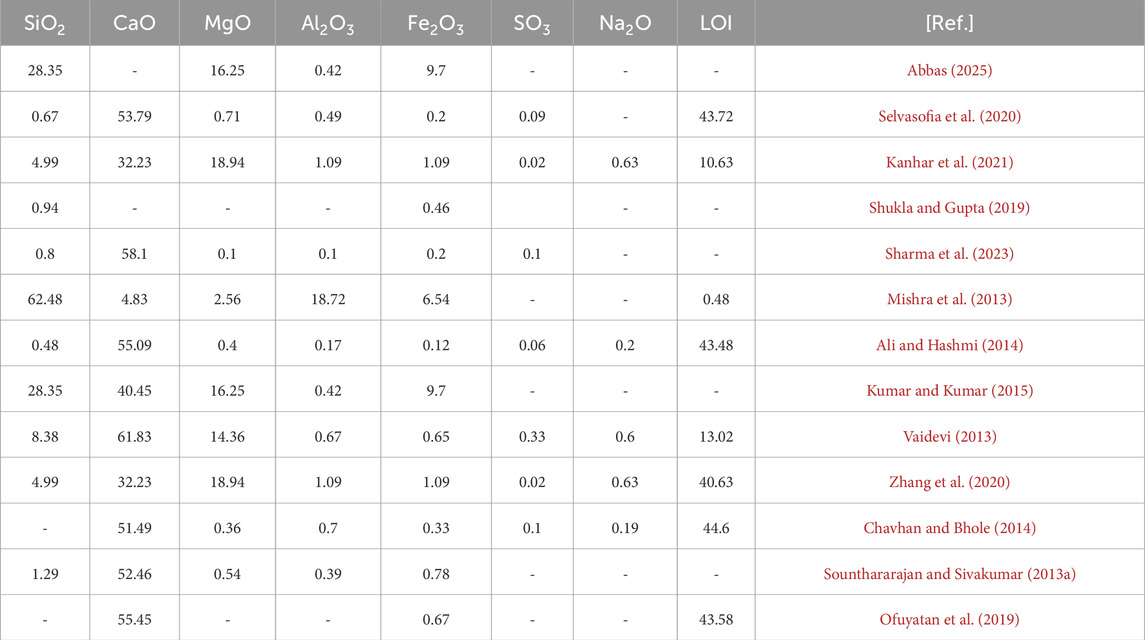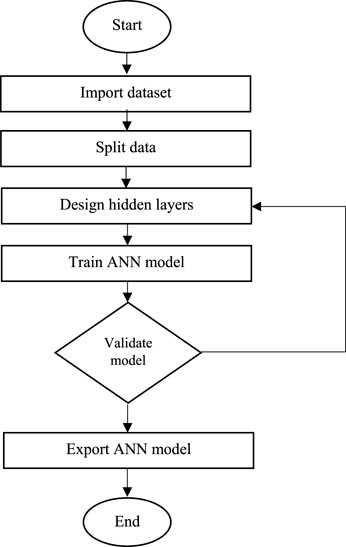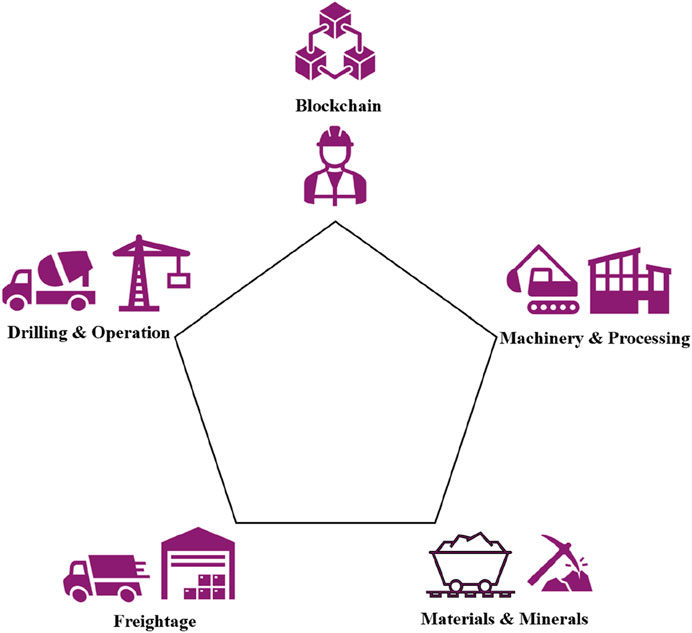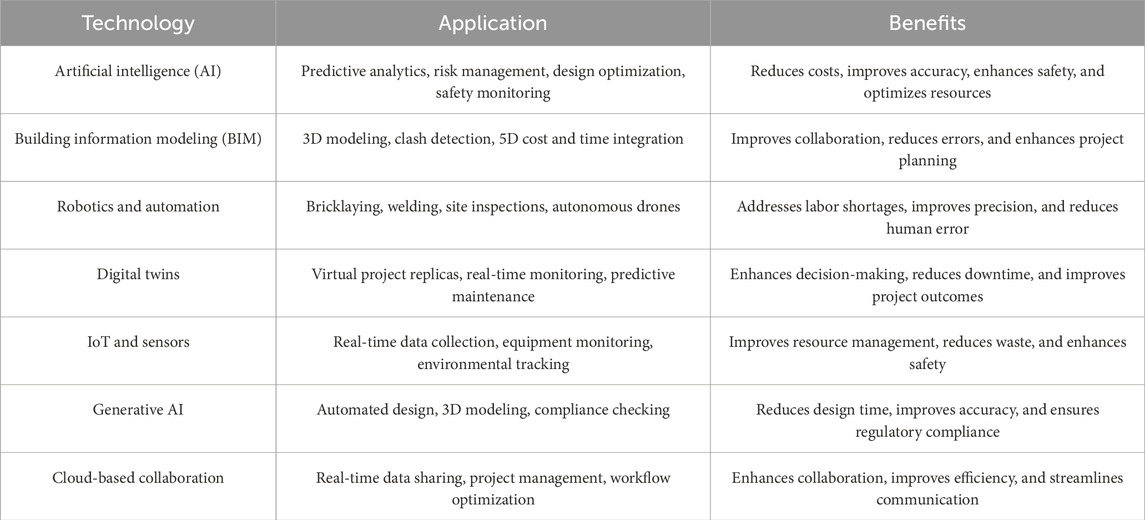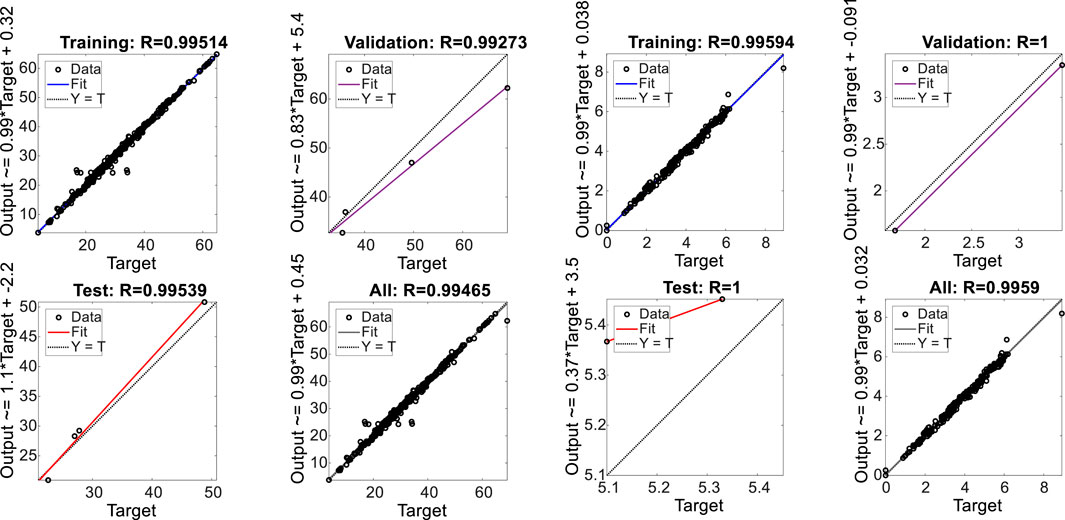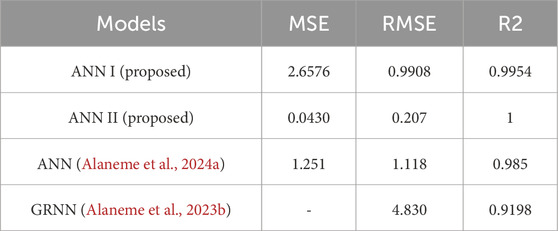- Faculty of civil Engineering, Transilvania University of Braşov, Braşov, Romania
Use of marble powder—an industrial by-product—serves as a supplementary cementitious material (SCM) and ensures sustainability by minimizing environmental impacts of cement manufacturing. This paper suggests a novel use of artificial neural networks (ANN) and Blockchain-Rock technology to enhance predictive accuracy and assure tracking of data in concrete mix optimization. Using an ANN model trained on 629 data sets, the proposed approach achieved high predictive accuracy for mechanical properties of marble powder concrete: Model I reached R2 = 0.99 and RMSE = 1.63 on the test set, while Model II achieved R2 = 1.00 and RMSE = 0.21. These results are superior or comparable to those of other machine learning models, such as a feedforward ANN (R2 = 0.985, RMSE = 1.12) and a general regression neural network (GRNN) (R2 = 0.92, RMSE = 4.83), highlighting the effectiveness of the proposed ANN architecture. This demonstrates the ANN’s ability to efficiently predict compressive and tensile strength of marble powder concrete, substantially reducing the need for standard long-duration tests. Additionally, Blockchain-Rock ensures secure and tamper-free tracking of material origin and concrete mixes, enabling transparency and efficiency in the supply chain. Experiments demonstrate that the addition of marble powder improves concrete strength and durability. Furthermore, ANN-based predictions enable real-time optimization of the concrete mix design. This dual approach offers an extended solution for sustainable construction by leveraging AI-based efficiency and blockchain-based data security. Future work can explore additional enhancements by real-time IoT integration and larger data sets to further improve predictive accuracy and industrial applicability.
1 Introduction
Marble powder is one of the Supplementary Cementitious Materials (SCMs) that used to replace cement for more sustainable concrete, while compressive and Tensile concrete tests are important for us to know the quality of the concrete that we use to build, the testing samples process itself takes at least 28 days for concrete to have its maximum strength to have more reliable results.
The construction industry requires, for sustainability, more natural building materials; the CO2 emissions are tremendously high, affecting the environment due to the manufacturing of cement (Abbas and Muntean, 2025). The effective solution for the problems considered above will consist in the search for methodologies that minimize excessive consumption of natural materials. Among them, one may list the rational application of industrial waste during the preparation of concrete mixes (Abbas and Muntean, 2025; González-Vallejo et al., 2020; Woź niak et al., 2022; Agarwal and Gulati, 2006; Latawiec et al., 2018). Marble industry generates substantial amounts of waste that can be utilized as a by-product along with cement to produce environmentally friendly concrete (Molnar and Manea, 2016).
Construction waste management (CWM) is a complex adaptive system and a holistic strategy that involves controlled treatment, reduction, reuse, and recycling (Jueyendah et al., 2021), and effective final disposal of waste generated from building, converting waste from the building and manufacturing sectors into valuable products (Trtnik et al., 2009). Simultaneously, it promotes sustainability and cost reduction. Successful CWM reduces damage through avoidance of soil and water contamination, pollution of the atmosphere, and habitat disruption, and avoidance of methane gas emitted by landfill sites (Kelechi Enobie et al., 2024), Through diversion of waste and employment of recycled materials, natural materials and energy are conserved based on the principle of circular economy, where material is kept in circulation over a considerable amount of time (Kelechi Enobie et al., 2024).
A Circular Economy (CE) principle in CWM represents a paradigm shift from a linear “take-make-consume-dispose” model of a conventional economy to a restorative one. The circular process aims to have assets in service for longer, getting the highest value from them with minimal waste generation (Gherman et al., 2023; E. Parliament, 2023). The paradigm is termed a core new sustainable principle to optimize waste management in the construction industry. The advantages of embracing a CE in CWM are. It reduces the amount of waste to landfill sites, saves on natural resources, and even reduces greenhouse gases through reduced new production energy demands. The methodology fosters a more robust building industry that is not so dependent on volatile global supply chains and subject to material shortages.
Blockchain (BC) Technology is one of the best methods that can be used in Waste Management (WM) permanently because BC keeps data inside a chained sequence of blocks, thereby making it simple to track changes through calculating a single-block’s hash value and comparing it with recorded hash value inside a nearby block (Motasem 2024) Researchers proceeded to elaborate on how BC today is used in WM in payment facilitation, tracking, waste monitoring. There are also BC applications that are already in place like Swachhcoin (BC mechanism for effective and eco-friendly micromanagement of trash from homes and businesses and making them into valuable commodities), Recereum (BC platform for recycling wastes and turning them into real value), and Plastic Bank (BC program that focuses on monetizing users in order to keep trash out of ocean). Furthermore, BC can also be used in a cloud system to give a boost to the security of WM making it possible for individuals to participate actively within WM through mobile phone and personal computer (Taylor et al., 2020; Researchgate, 2019). BC even has solutions to core areas named, fraud and manipulation, incorrect/loss of data, manual processing and absence of knowledge and control found within WM practices (França et al., 2020).
In CWM, blockchain integration has a lot of potential by allowing harmonious platforms for managing data and accelerating circular economy CE concepts by means of improved collaboration. That potential can be boosted by drawing on integration strategy applicable to construction. A key strategy involves using smart contracts on platforms like Ethereum to achieve a secure peer-to-peer network within waste processing streams. While references provided do not directly refer to blockchain-based solutions like Swachhcoin, Recereum, Plastic Bank, or DanKu protocol specially applied to waste within construction, the references lay emphasis on blockchain nature like decentralization, immutability, and openness to play a vital role in effective waste tracking and measurement optimization, crucial to CE methods. In addition to that, blockchain’s ability to integrate other digital technologies like BIM, IoT, and RFID, explored to apply to the general context of construction, also supports its contribution to overall waste handling by simplifying real-time tracking, furthering improved data exchange, and automated verifications along waste lifecycle (Mahmudnia et al., 2022; Perera et al., 2020; Yang et al., 2020; Souza Barreto et al., 2020).
By applying ANN (see Figure 1) on the prediction of compressive and tensile strength: This will reduce the amount of time wasted in procedures. It will eliminate such long curing and physical testing activities by directly assessing the quality of concrete. With a well-trained ANN model, decisions can be made quickly over mix design optimization in real time to improve project efficiencies.
The current study aims to provide an ANN model that would be able to predict the compressive and tensile strength of marble concrete. In this respect, 629 data from previous works have been selected with much care, and factors like cement, coarse and fine particles, water, and specimen curing age were taken as a number of these parameters is considered significant determinants of compressive and tensile strength of conventional concrete.
ANN systems have lately become popular, and many researchers have used them for different engineering applications. Laboratory tests are carried out to get the physical and mechanical properties of concrete. By simulating human brains, ANNs may learn from experience the connections between certain inputs and outputs (Molnar and Manea, 2016; Bilim et al., 2009; Demir, 2008; Topc¸u and Sarıdemir, 2008a; Sarıdemir et al., 2009; Lee, 2003; Parichatprecha and Nimityongskul, 2009; O¨ zcan et al., 2009; Topc¸u and Sarıdemir, 2008b; Tanyildizi, 2009). An ANN uses an activation function to generate an output, a learning algorithm to modify the weights, and a set of patterns from a training database as input (Cevik and Guzelbey, 2008; Hou et al., 2008; Topc¸u and Sarıdemir, 2008c).
The ANN is a biologically inspired computational technique that will map the relations of n-dimensional input and output vectors very accurately. In this architecture, the so-called hidden layers composed of hidden neurons are sandwiched between an input and an output layer, where the input layer represents nodes for the input variables and the output layer is utilized to express the outputs of the model. How these three layers are combined is demonstrated in Table 1 (Zadeh, 1965).
These are the connections between the three layers, linked to weights initially set by the network creator but changed iteratively for every “epoch” that the network goes through. Because it reduces the error function of the network output to a predetermined threshold or limit-as instructed by the gradient descent optimization-it provides weight after weight which, in the end, converges with respect to the final values. Or in other words, the number of converged epochs reaches to its maximum until convergence is attained. Each hidden neuron has an associated activation function acting on the weighted sum of inputs it gets from the preceding layer for feeding the result of this function to the subsequent layer and so on until the final output layer. This procedure from the input layer to the output layer is called the feed-forward step. The Backpropagation technique helps in re-adjusting the weights of the network during the learn phase such that the input gets mapped with a more accurate output with a reduced Mean Squared Error. In the process, this results in converging the error to a reasonable margin below a certain threshold (Zadeh, 1965).
It is this mapping capability of ANNs in complex nonlinear relations that have made them quite applicable in fields like engineering and material sciences, including concrete property predictions. While the number of hidden layers and the number of neurons within each layer are problem-dependent, more complicated problems are modeled with deeper architectures. The model is very sensitive to network performance for proper preprocessing of the data, which must at least involve one step of normalization or standardization, in a way that it could make sure the input features must be well scaled to avoid over-problems within exploding or vanishing phases during backpropagation, including diverse activation functions that will be leveraged for capturing complex conditions, Recent breakthroughs in machine learning add the additional capabilities of accurately predicting concrete characteristics, thereby optimizing material performance by reducing the need for excessive physical tests (Trtnik et al., 2009).
Overall, the training of the ANN should be performed on a partition of data into training, validation, and testing subsets so as not to have any generalization problem or overfitting. The model generalization might get improved by applying some regularization techniques, including dropout, or L2 regularization methods. Generally speaking, more sophisticated optimization algorithms, such as the adaptive methods Adam or RMSprop, should be used, since they ensure faster convergence and improvement in general performance. ANNs are flexible in that they can fit into a wide range of problem domains by changing their architecture and hyperparameters, making them a mighty tool for predictive modeling and pattern recognition.
Recent research has explored the use of artificial intelligence to predict the mechanical properties of various sustainable concretes. For example, Jiang et al. (2023) applied AI to forecast the properties of banana peel-ash and bagasse blended geopolymer concrete, demonstrating the versatility of machine learning in sustainable materials. Other studies have proposed simplified AI-based methodologies for geopolymer concrete mix design (Alaneme et al., 2024a), and critical reviews have highlighted the growing role of AI in optimizing geopolymer concrete production (Alaneme et al., 2024b). Additionally, systematic reviews emphasize the eco-friendly potential of agro-waste-based geopolymer concrete (Alaneme et al., 2023a). Compared to these works, this study integrates marble powder as a cement replacement and combines ANN prediction with blockchain-based material tracking, addressing both performance optimization and supply chain transparency.
Though previous work on ANN-based concrete strength prediction exists, few have brought together AI-based prediction and blockchain technology for tracking and sustainability in material sources and construction. This paper presents a novel approach by combining ANN with Blockchain-Rock to predict the mechanical characteristics of marble powder concrete as well as providing transparency and security in material sources and construction. This dual approach encourages real-time mix design decision-making and addresses sustainability challenges in construction.
2 Construction materials digitalization
Future megatrends, that is, urbanisation, resource efficiency, as well as globalisation, are transformative drivers with far-reaching social, economic, business, culture, as well as human impacts. Specifically, digital technologies are remaking these areas in all industries as well as on all continents. Work methods (see Table 2) in design as well as construction have been changed by digitalization (see Figure 2) with highly accurate models that allow planning, designing, constructing, assembling, operation, as well as maintenance (Papayianni and Pachta, 2017).
However, construction material development as well as construction methods have not followed that of architecture and civilizations. All construction technologies developments have in turn relied on construction material (Rajesh et al., 2024), although its sustainability is not always prioritized. The impact buildings have on nature is not realized by society (Papayianni et al., 2016) as much as it is supposed to be. In consideration of digitalization as well as sustainability, construction material as well as construction technologies increasingly have to be reevaluated with consideration towards a more healthy environment.
Several innovations have been made known, and scholars from a variety of disciplines are enthusiastic. Some are developments in deep learning, having big data available for benchmarks, as well as algorithmic developments in terms of activation functions, initialization schemes in weights, as well as improved schemes in terms of optimization. To sense damage in structures (Selvasofia et al., 2020) (Kanhar et al., 2021), cracking in concrete (Shukla and Gupta, 2019) (Sharma et al., 2023), structural elements in bridges (Mishra et al., 2013), in asphalt (Ali and Hashmi, 2014), tunnels (Kumar and Kumar, 2015), towers in transmission (Vaidevi, 2013), as well as ceiling (Zhang et al., 2020), civil engineers have utilized new computer science. The construction sector is far from leading in terms of innovation as a sector because it lacks creativity as well as innovation, as well as more importantly, poor sustainability performances (Chavhan and Bhole, 2014). Innovations involve a broad spectrum of transformative systems such as AI as well as ANN, which can assist in the growth of the construction sector, but whose prospect is eroded by a lack of internet-based data.
Use of marble powder as cement substitute is critical in light of environmental impacts from dumping marble waste as well as construction sector sustainability objectives construction sector is increasingly interested in sustainability. In cement, marble powder, a high surface area material that is a by-product from marble grinding, can be a cement substitute, application of marble powder as cement substitute holds promise in terms of cost as well as environmental impacts in conformity with sustainable construction (Khodabakhshian et al., 2018; Khan et al., 2022; Nega et al., 2023).
629 entries (see Figure 3 and Table 3) (Shukla and Gupta, 2019; Sharma et al., 2023; Mishra et al., 2013; Ali and Hashmi, 2014; Kumar and Kumar, 2015; Vaidevi, 2013; Zhang et al., 2020; Chavhan and Bhole, 2014; Ofuyatan et al., 2019; Ghani et al., 2020; Lezzerini et al., 2022; Chandrasekaran, 2017; Gopi et al., 2017; Rao, 2016; Dhanalakshmi et al., 2022; AshaLak et al., 2019; Chandrakar and Singh, 2017; Majeed et al., 2021; Sharma et al., 2019; Shirule et al., 2012; Pal et al., 2016; Singh et al., 2019; Ris et al., 2014; Sounthararajan and Sivakumar, 2013b; Latha et al., 2015) from available studies on Marble powder (MP) effects on cement as well as durability in concrete have been utilized in this research. Waste management. To promote not just the mechanical properties but also sustainability in concrete, cement in varying ratios replaced these. The output parameter in the database was concrete strength, with input parameters consisting of cement quantity, quantity of fine aggregate (FA), quantity of coarse aggregate (CA), water, Marble powder substitute ratios as well as age in curing.
2.1 Blockchain-rock
Blockchain is an integrated decentralized database made up of multiple technologies in which every node in the chain stores the entire database and ensures data consistency through hash algorithms, digital signatures, consensus protocols, smart contracts, and peer-to-peer networks (Hautala et al., 2017; Wu and Margarita, 2024). Consensus algorithms enable all the nodes to verify blocks and ensure secure and transparent data management. With its distributed data storage architecture and cryptography-based security features, blockchain provides open, tamper-evident, and trackable access to data and thus is a disruptive technology that decentralizes the management of trust and redefines cyber technology (Hautala et al., 2017; Kaur et al., 2021). It has drawn significant interest in cryptocurrencies, smart cities, and the Internet of Things. Technologically, blockchain redefines the recording, storage, and management of data and enables the shift from an information-based Internet to a value-based Internet. Marketwise, its decentralized and transparent nature reduces the use of intermediaries and the costs of trust and encourages economic efficiency (Hautala et al., 2017).
Blockchain technology can facilitate in-depth end-to-end tracing of minerals and ores. This involves marking sealed containers or ore and concentrate bags with a special number later to be entered into the blockchain. This number will be updated regularly with a constant timeline tracking and recording movement and information on the quality and quantity of each parcel of ore or concentrate. This will have two immediate applications: first, it will bring confidence to clients in the movement of valuable minerals, and secondly, it will make it easy to verify that minerals purchased are from conflict- and law-abiding sources (Ali et al., 2020).
Blockchain-Rocks focuses on utilizing blockchain technology in the sedimentary rock layers supply chain. This use ensures transparency, security, and efficiency in tracking the distribution and sales of rock formations and other minerals. Some of the key principles involved are:
1. Cryptography–Ensures confidentiality and integrity of transactions.
2. Decentralization–Takes away centralized power, allowing users to independently validate transactions.
3. Consensus Mechanism–All transactions are confirmed as a group to ensure accuracy and prevent unauthorized modifications.
Construction and demolition waste (CDW) in the European Union (EU) accounts for approximately a third of all the waste in the region. This issue is further aggravated by inadequate treatment and management where much of the waste is unable to be reused in the value chain. Efficient management of CDW by appropriate handling and material recycling can reap huge dividends in sustainability, quality of life, and economic development. Strengthening the demand for recycled materials can further contribute to the construction and recycling industries. One of the principal barriers, however, lies in the lack of digital competences—44% of the population and 37% of the workforce in the EU lack the basic level of digital competences as per the European Commission (Onifade et al., 2024).
The rising rate of waste production poses difficulties in identifying appropriate destinations for proper waste management. While technological advancement in the shape of the Internet of Things (IoT) and smart sensors can facilitate data collection, it does not necessarily imply correct and secure data handling on its own. The immense amount of data requires credibility and security in information transfer between the stakeholders where the use of Blockchain technology becomes essential (Cristóbal García et al., 2024).
Blockchain has been widely applied in recent times in a number of fields, most prominently in environmental sustainability. It offers huge advantages in strategic planning, environmental tracking, logistics, and green supply chain management. Besides this, the application of Blockchain in urban circular economies ensures data integrity and security in smart cities (Casino et al., 2019).
The basis of 21st-century social and economic development will be digital technology. Therefore, it becomes essential to make use of their full potential in order to sustain an economy in favor of society and the environment (Kshetri, 2018).
3 Materials & methods
3.1 Research and data retrieval methodology
The ANN data were manually gathered by looking at several Marble publications. A thorough literature study was carried out in order to develop a reliable framework for forecasting the compressive and tensile strength of concrete using artificial neural networks (ANNs) see Figure 2 and Table 4. Targeted were important research that highlighted the function of supplemental cementitious materials (SCMs) in environmentally friendly building. The following standards were met by the data collection:
• Publications with peer review
• Research must be published within the recent years.
• Studies that specifically examined the use of marble powder in the mix design.
The following retrieval method was used to create a dataset of 629 items from different academic journals:
3.2 Data selection criteria
Several important criteria served as a guide for the inclusion of works in this domain:
3.2.1 Relevance to sustainable construction
• The research must address critical issues such as of Marble for enhanced concrete durability, mechanical strength, and eco-friendliness.
• Studies providing insights into optimizing concrete mix designs using ANNs were prioritized.
3.2.2 Methodological consistency
• The chosen research must use strong, repeatable procedures, such as cutting-edge data science methods.
• Studies showing creative ANN uses to capture intricate nonlinear correlations in concrete characteristics were highly regarded.
3.2.3 Significance and practical impact
Studies that offered workable answers—like lessening the need for physical testing or improving real-time decision-making in concrete mix design—were given preference.
3.3 Information sources
The following sources were considered reliable and relevant for the study:
• Studies carried out in laboratory or real-world conditions, as long as they met strict quality requirements.
• Research from reputable scholarly publications, conferences, and organizations that focus on sustainable building and civil engineering.
• Data and reports from recognized organizations, such as industry standards committees and environmental authorities, that are accessible to the public.
3.4 Algorithm
The algorithm used is Levenberg-Marquardt as shown in Equations 1, 2 which is driven from Gauss Newton method the algorithm workflow shown in Figure 4.
Levenberg–Marquardt algorithm:
The research is based on a dataset of 629 entries collected from literature reviewing previous research in marble powder usage in concrete with the aim of enhancing concrete durability. Marble powder was partially replaced with cement in varying proportions with the aim of rendering sustainability and improving the mechanical properties of concrete. These include cement, FA, CA, water, SCMs, and curing age as input parameters, while the output parameter is the tensile strength of the concrete. Examples of some of the dataset used are shown in Table 2.
Figure 5 Graphical representation of the data collected marble powder was replaced with variable percentage of cement in studies and subsequently, the properties tested include the compressive strength and tensile strength test for their concrete samples. Such tests had given an indication of the possibility of usage of SCMs as a means to increase eco-friendliness in structural concretes by showing even longer service life.
4 Results
It is represented that the ANN models based on I-ANN and II-ANN architecture are trained and tested concerning two metrics-Mean Squared Error and correlation coefficient see Table 5 using 60 hidden neurons which resulted in minimum MSE with maximum predictive accuracy.
Results have shown that the addition of Marble powder increases the Compressive and tensile strength of concrete and generally enhances the durability of concrete. The curing time and water-to-cement ratio were the critical factors in controlling the compressive and tensile strength. ANN performance with testing data turned out to be excellent; hence, this approach is applicable (see Figures 6–10 and Table 6).
4.1 ANN training state plot
4.2 ANN Performance plot
4.3 ANN Error histogram
4.4 ANN Bivariate histogram
4.5 ANN Regression plot
4.6 Model Comparison
To evaluate the performance of the proposed ANN model, its results were compared with those of a Feedforward ANN model and a General Regression Neural Network (GRNN) regressor. Table 7 summarizes the comparative performance in terms of R2 and RMSE for compressive strength prediction.
5 User interface
For better usability, an application model was further developed upon the trained ANN. It further allows users to input certain values: marble powder in percentage, cement, time of curing, and finally water to cement ratio against which concrete compressive and tensile strength is predictable. Figure 11 presents the tool providing immediate insight so as to optimize concrete mixing designs and thereby reduce the current dependence on time-consuming, conventional test methods.
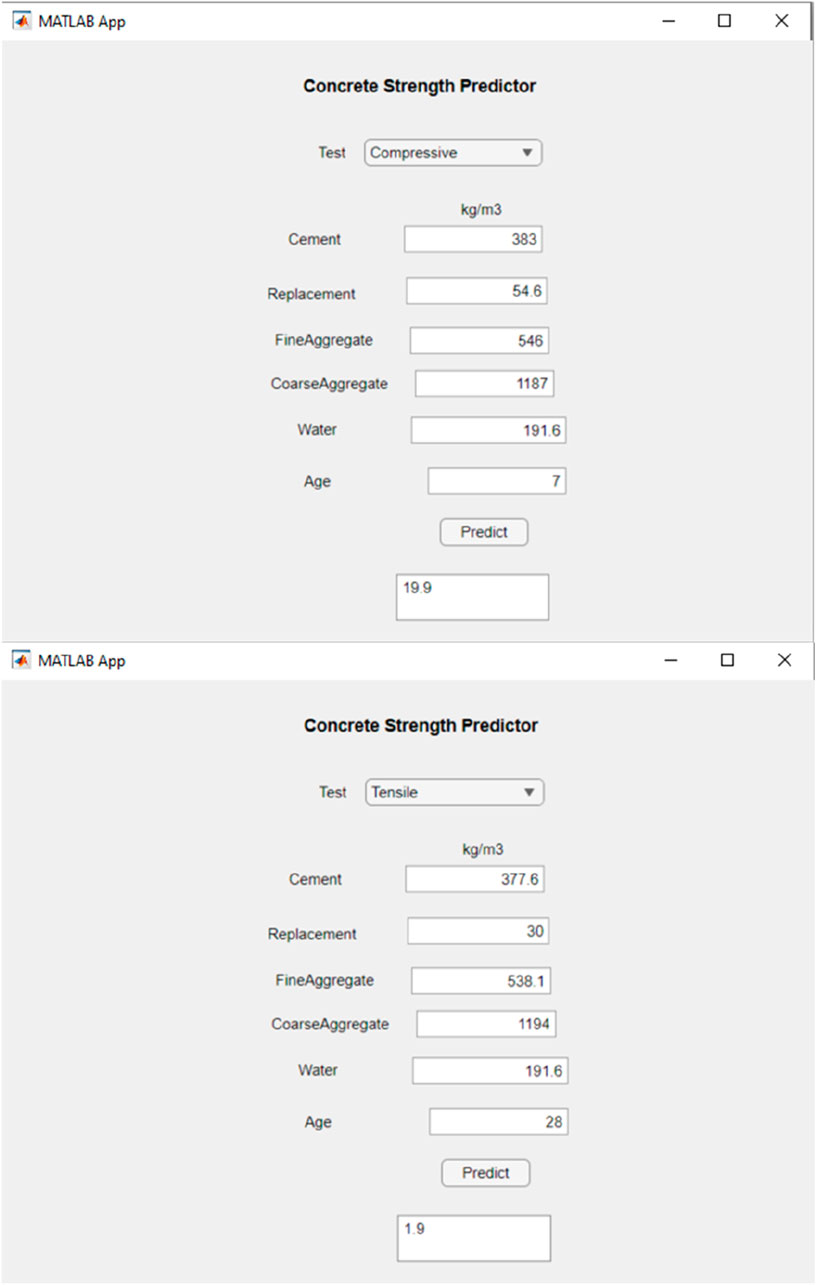
Figure 11. The developed application for predicting the compressive and tensile strength of concrete.
6 Summary and conclusion
This study developed and validated an artificial neural network (ANN) model for predicting the compressive and tensile strength of marble powder concrete, using a dataset of 629 samples. The model demonstrated high predictive accuracy, outperforming other machine learning techniques. In addition, the study introduced Blockchain-Rock technology to record and verify data related to material sources, mix designs, and predicted properties, thereby enhancing transparency and traceability in the concrete supply chain.
The integration of ANN and Blockchain-Rock offers a comprehensive solution for sustainable construction. ANN enables rapid and reliable prediction of concrete properties, reducing reliance on lengthy laboratory tests, while Blockchain-Rock ensures secure and tamper-proof documentation of all relevant data. This dual approach improves efficiency, quality assurance, and sustainability in the construction industry. Future research may explore real-time IoT integration and expansion to larger datasets to further enhance predictive accuracy and practical applicability.
By leveraging ANN, construction professionals can make real-time, data-driven decisions that improve material performance and structural reliability. The incorporation of marble powder as a supplementary cementitious material (SCM) further aligns with global sustainability efforts by minimizing waste and reducing cement consumption. Additionally, Blockchain-Rock enhances trust and accountability in material sourcing, reducing environmental and economic risks, for further research approaches:
• Expand the dataset to include a wider range of material properties and mix designs.
• Further optimize ANN architectures to enhance predictive accuracy.
• Explore deeper integration of Blockchain-Rock into construction workflows for improved quality control and lifecycle monitoring.
• Investigate real-time IoT integration to enable dynamic data collection and model updates.
• Continue to advance the combined use of AI and blockchain to drive smarter, more sustainable, and efficient construction practices.
Data availability statement
The original contributions presented in the study are included in the article/supplementary material, further inquiries can be directed to the corresponding author.
Author contributions
MA: Writing – original draft, Visualization, Software, Investigation, Methodology, Conceptualization. RM: Project administration, Resources, Validation, Formal Analysis, Data curation, Supervision, Writing – review and editing.
Funding
The author(s) declare that financial support was received for the research and/or publication of this article. This research was conducted as part of the RockChain project – “Transversal Technological Skills for the Ornamental Rock Industry Focusing on the Applicability of Blockchain in a Circular Economy” (Project code: 2023-1-DE02-KA220-ADU-000166863), co-funded by the European Union through the Erasmus+ programme.
Acknowledgments
We gratefully acknowledge the support and collaboration of all project partners, with special thanks to Transilvania University of Brașov. We also extend our appreciation to the reviewers for their insightful comments and suggestions, which have significantly improved the quality of this manuscript.
Conflict of interest
The authors declare that the research was conducted in the absence of any commercial or financial relationships that could be construed as a potential conflict of interest.
Generative AI statement
The author(s) declare that no Generative AI was used in the creation of this manuscript.
Publisher’s note
All claims expressed in this article are solely those of the authors and do not necessarily represent those of their affiliated organizations, or those of the publisher, the editors and the reviewers. Any product that may be evaluated in this article, or claim that may be made by its manufacturer, is not guaranteed or endorsed by the publisher.
References
Abbas, M. M. (2025). Recycling waste materials in construction: mechanical properties and predictive modeling of waste-derived cement substitutes. Waste Manag. Bull. 3, 168–192. doi:10.1016/j.wmb.2025.01.004
Abbas, M. M., and Muntean, R. (2025). Marble powder as a sustainable cement replacement: a review of mechanical properties. Sustainability 17 (2), 736. doi:10.3390/su17020736
Agarwal, S. K., and Gulati, D. (2006). Utilization of industrial wastes and unprocessed micro-fillers for making cost-effective mortars. Constr. Build. Mater. 20 (10), 999–1004. doi:10.1016/j.conbuildmat.2005.06.009804
Alaneme, G. U., Olonade, K. A., and Esenogho, E. (2023a). Critical review on the application of artificial intelligence techniques in the production of geopolymer-concrete. SN Appl. Sci. 5, 217. doi:10.1007/s42452-023-05447-z
Alaneme, G. U., Olonade, K. A., and Esenogho, E. (2023b). Eco-friendly agro-waste based geopolymer-concrete: a systematic review. Discov. Mater 3, 14. doi:10.1007/s43939-023-00052-8
Alaneme, G. U., Olonade, K. A., Esenogho, E., and Lawan, M. M. (2024a). Proposed simplified methodological approach for designing geopolymer concrete mixtures. Sci. Rep. 14, 15191. doi:10.1038/s41598-024-66093-y
Alaneme, G. U., Olonade, K. A., Esenogho, E., Lawan, M. M., and Dintwa, E. (2024b). Artificial intelligence prediction of the mechanical properties of banana peel-ash and bagasse blended geopolymer concrete. Sci. Rep. 14, 26151. doi:10.1038/s41598-024-77144-9
Ali, M. M., and Hashmi, S. M. (2014). An experimental investigation on strengths characteristics of concrete with the partial replacement of cement by marble powder dust and sand by stone dust. IJSRD—Int. J. Sci. Res. Dev. 2, 81–84. Available online at: https://www.ijsrd.com
Ali, R., Qadri, Y. A., Zikria, Y. B., Al-Turjman, F., Kim, B. S., and Kim, S. W. (2020). A blockchain model for trustworthiness in the internet of things (IoT)-based smart-cities. Trends cloud-based IoT, 1–19. doi:10.1007/978-3-030-40037-8_1
AshaLakshmi, G., and Pravallika, P. S. (2019). Strength and durability properties of concrete with partial replacement of cement with metakaoline and marble dust. Int. Res. J. Eng. Technol. (IRJET) 6 (11), 1686. Available online at: https://www.irjet.net.
Bilim, C., Atiş, C. D., Tanyildizi, H., and Karahan, O. (2009). Predicting the compressive strength of ground granulated blast furnace slag concrete using artificial neural network. Adv. Eng. Softw. 40, 334–340. doi:10.1016/j.advengsoft.2008.05.005
Casino, F., Dasaklis, T. K., and Patsakis, C. (2019). A systematic literature review of blockchain-based applications: current status, classification and open issues. Telematics Inf. 36, 55–81. doi:10.1016/j.tele.2018.11.0061
Cevik, A., and Guzelbey, I. H. (2008). Neural network modeling of strength enhancement for CFRP confined concrete cylinders. Build. Environ. 43, 751–763. doi:10.1016/j.buildenv.2007.01.036
Chandrakar, R., and Singh, A. (2017). Cement replacement in concrete with marble dust powder. Int. Res. J. Eng. Technol. 4 (5), 67–71. Available online at: http://www.irjet.net.
Chandrasekaran, V. (2017). Partial replacement of cement with marble powder in concrete. Eng. Civ. 7, 47. doi:10.5958/2231-3915.2017.00009.8
Chavhan, P. J., and Bhole, S. D. (2014). To study the behaviour of marble powder as supplementary cementitious material in concrete. Int. J.Eng. Res. Appl. 4, 377–381. Available online at: https://www.ijera.com
Cristóbal García, J., Caro, D., Foster, G., Pristerà, G., Gallo, F., and Tonini, D. (2024). Techno-economic and environmental assessment of construction and demolition waste management in the European Union: Status quo and prospective potential (JRC Technical Report No. JRC135470; EUR 31784 EN). Luxembourg: Publications Office of the European Union. doi:10.2760/721895
Demir, F. (2008). Prediction of elastic modulus of normal and high strength concrete by artificial neural networks. Constr. Build. Mater 22, 1428–1435. doi:10.1016/j.conbuildmat.2007.04.004
Dhanalakshmi, A., and Hameed, M. S. (2022). Strength properties of concrete using marble dust powder. East Asian J. Multidiscip. Res. 1 (11), 2521–2530. doi:10.55927/eajmr.v1i11.1785
E. Parliament (2023). Circular economy: definition, importance and benefits | News. European Parliament. Available online at: https://multimedia.europarl.europa.eu/en/video/v_V007-0034.
França, A. S. L., Amato Neto, J., Gonçalves, R. F., and Almeida, C. M. V. B. (2020). Proposing the use of blockchain to improve the solid waste management in small municipalities. J. Clean. Prod. 244, 118529. doi:10.1016/j.jclepro.2019.118529
Ghani, A., Ali, Z., Khan, F. A., Shah, S. R., Wali Khan, S., and Rashid, M. (2020). Experimental study on the behavior of waste marble powder as partial replacement of sand in concrete. SN Appl. Sci. 2, 1554. doi:10.1007/s42452-020-03349-y
Gherman, I.-E., Lakatos, E. S., Clinci, S. D., Lungu, F., Constandoiu, V. V., Cioca, L. I., et al. (2023). Circularity outlines in the construction and demolition waste management: a literature review. Recycling 8 (5), 69. doi:10.3390/recycling8050069
González-Vallejo, P., Muntean, R., Solís-Guzmán, J., and Marrero, M. (2020). Carbon footprint of dwelling construction in Romania and Spain: a comparative analysis with the OERCO2 tool. Sustainability 12 (17), 6745. doi:10.3390/su12176745
Gopi, R., Kaleeswari, G., and Dhanalakshmi, G. (2017). Study on marble powder as partial replacement of cement in concrete. GRD J. Eng. 2 (7), 1–5. doi:10.2139/grdje.2017.0027
Hautala, K., Järvenpää, M.-E., and Pulkkinen, P. (2017). Digitalization transforms the construction sector throughout asset's life-cycle from design to operation and maintenance. Fachthemen. doi:10.1002/stab.201710474
Hou, T.-H., Su, C.-H., and Chang, H.-Z. (2008). Using neural networks and immune algorithms to find the optimal parameters for an IC wire bonding process. Expert Syst. Appl. 34, 427–436. doi:10.1016/j.eswa.2006.09.024
Jiang, P., Zhang, L., You, S., Fan, Y. V., Tan, R. R., Klemeš, J. J., et al. (2023). Blockchain technology applications in waste management: overview, challenges and opportunities. J. Clean. Prod. 1 427, 138466. doi:10.1016/j.jclepro.2023.138466
Jueyendah, S., Lezgy-Nazargah, M., Eskandari-Naddaf, H., and Emamian, S. A. (2021). Predicting the mechanical properties of cement mortar using the support vector machine approach. Constr. Build. Mater. 291, 123396. doi:10.1016/j.conbuildmat.2021.123396
Kanhar, R. A., Memon, M. J., Sandhu, A. R., Jhatial, A. A., and Mastoi, A. K. (2021). Mechanical properties of concrete incorporating marble powder as partial cement replacement. Quaid-E-Awam Univ. Res. J. Eng. Sci. Technol. 19, 59–64. doi:10.52584/qrj.1901.08
Kaur, S., Chaturvedi, S., Sharma, A., and Kar, J. (2021). A research survey on applications of consensus protocols in blockchain. Secur. Commun. Netw. 2021 (1), 6693731–22. doi:10.1155/2021/6693731
Kelechi Enobie, B., Chukwudi Okwandu, A., Abdulwaheed, S. A., and Iwuanyanwu, O. (2024). Effective waste management in construction: techniques and implementation. Int. J. Appl. Res. Soc. Sci. 6 (8), 1642–1652. doi:10.51594/ijarss.v6i8.1390
Khan, K., Ahmad, W., Amin, M. N., Ahmad, A., Nazar, S., Alabdullah, A. A., et al. (2022). Exploring the use of waste marble powder in concrete and predicting its strength with different advanced algorithms. Materials 15, 4108. doi:10.3390/ma15124108
Khodabakhshian, A., de Brito, J., Ghalehnovi, M., and Asadi Shamsabadi, E. (2018). Mechanical, environmental and economic performance of structural concrete containing silica fume and marble industry waste powder. Constr. Build. Mater. 169, 237–251. doi:10.1016/j.conbuildmat.2018.02.192
Kshetri, N. (2018). Blockchain’s roles in meeting key supply chain management objectives, Int. J. Inf. Manage. 39, 80–89. doi:10.1016/j.ijinfomgt.2017.12.005
Kumar, R., and Kumar, S. K. (2015). Partial replacement of cement with marble dust powder. Int. J. Eng. Res. Appl. 5, 106–114. Available online at: http://www.ijera.com.
Latawiec, R., Woyciechowski, P., and Kowalski, K. J. (2018). Sustainable concrete performance—CO2 emission. Environments 5 (2), 27. doi:10.3390/environments5020027
Latha, G., Reddy, A. S., and Mounika, K. (2015). Experimental investigation on strength characteristics of concrete using waste marble powder as cementitious material. Int. J. Innovative Res. Sci. Eng. Technol. 4 (12), 1070–1075. doi:10.15680/IJIRSET.2015.0412070
Lee, S.-C. (2003). Prediction of concrete strength using artificial neural networks. Eng. Struct. 25, 849–857. doi:10.1016/s0141-0296(03)00004-x
Lezzerini, M., Luti, L., Aquino, A., Gallello, G., and Pagnotta, S. (2022). Effect of marble waste powder as a binder replacement on the mechanical resistance of cement mortars. Appl. Sci. 12 (9), 4481. doi:10.3390/app12094481
Mahmudnia, D., Arashpour, M., and Yang, R. (2022). Blockchain in construction management: applications, advantages and limitations. Autom. Constr. 140, 104379. doi:10.1016/j.autcon.2022.104379
Majeed, M., Khitab, A., Anwar, W., Khan, R. B. N., Jalil, A., and Tariq, Z. (2021). Evaluation of concrete with partial replacement of cement by waste marble powder. Civ. Eng. J. 7 (01), 59–70. doi:10.28991/cej-2021-03091637
Mishra, A., Pandey, A., Maheshwari, P., Chouhan, A., Suresh, S., and Das, S. (2013). Green cement for sustainable concrete using marble dust. Int. J. ChemTech Res. 5, 616–622.
Molnar, L. M., and Manea, D. L. (2016). New types of plastering mortars based on marble powder slime. Procedia Technol. 22, 251–258. doi:10.1016/j.protcy.2016.01.076
Motasem, A., Ahmed, A., Murat, E., Tahra, A., Salem, A., Eddin, N. D., et al. (2024). Overview of circular economy management approach for sustainable construction and demolish waste management an overview of circular economy management approach for sustainable construction and demolish waste management. An, Glob. NEST J. 26 (6), 5824. doi:10.30955/gnj.005824
Nega, D. M., Yifru, B. W., Taffese, W. Z., Ayele, Y. K., and Yehualaw, M. D. (2023). Impact of partial replacement of cement with a blend of marble and granite waste powder on mortar. Appl. Sci. 13, 8998. doi:10.3390/app13158998
Ofuyatan, O. M., Olowofoyeku, A. M., Obatoki, J., and Oluwafemi, J. (2019). Utilization of marble dust powder in concrete. In IOP Conf. Ser, Mater. Sci. Eng. IOP Publishing: Bristol, UK, 640. 012053, doi:10.1088/1757-899x/640/1/012053
Onifade, M., Adebisi, J. A., and Zvarivadza, T. (2024). Recent advances in blockchain technology: prospects, applications and constraints in the minerals industry. Int. J. Min. Reclam. Environ. 38 (7), 497–533. doi:10.1080/17480930.2024.2319453
Ö zcan, F., Atiş, C. D., Karahan, O., Uncuoğlu, E., and Tanyildizi, H. (2009). Comparison of artificial neural network and fuzzy logic models for prediction of long-term compressive strength of silica fume concrete. Adv. Eng. Softw. 40 (9), 856–863. doi:10.1016/j.advengsoft.2009.01.005
Pal, S., Singh, A., Pramanik, T., Kumar, S., and Kisku, N. (2016). Effects of partial replacement of cement with marble dust powder on properties of concrete. IJIRST – Int. J. Innovative Res. Sci. and Technol. 3 (3), 1–6.
Papayianni, I., and Pachta, V. (2017). Earth block houses of historic centers. a sustainable upgrading with compatible repair materials. Procedia Environ. Sci. 38, 274–282. doi:10.1016/j.proenv.2017.03.076
Papayianni, I., and Pachta, V. (2016). “Evolution of building materials and philosophy in construction: a process of digitalization and visualization of the accumulated knowledge,” in EuroMed 2016, Part I, LNCS 10058. Editor M. Ioannides, and et al. (Springer International Publishing), 199–208. doi:10.1007/978-3-319-48496-9_16
Parichatprecha, R., and Nimityongskul, P. (2009). Analysis of durability of high performance concrete using artificial neural networks. Constr. Build. Mater 23, 910–917. doi:10.1016/j.conbuildmat.2008.04.015
Perera, S., Nanayakkara, S., Rodrigo, M. N. N., Senaratne, S., and Weinand, R. (2020). Blockchain technology: is it hype or real in the construction industry? J. Ind. Inf. Integr. 17, 100125. doi:10.1016/j.jii.2020.100125
Rajesh, A. A., Prasanthni, P., Senthilkumar, S., and Priya, B. (2024). Environment-friendly sustainable concrete produced from marble waste powder. Glob. NEST J. 26, 05204.
Rao, B. K. (2016). Study on marble powder as partial replacement of cement in normal compacting concrete. IOSR J. Mech. Civ. Eng. (IOSR-JMCE) 13 (4), 1–5. doi:10.9790/1684-1304030105
Researchgate (2019). Blockchain based waste management. Available online at: https://www.researchgate.net/publication/334162200.
Ris, H., Aggarwal, V., and Aggarwal, D. V. (2014). Effect on partial replacement of fine aggregate and cement by waste marble powder/granules on flexural and split tensile strength. IOSR J. Mech. Civ. Eng. 11 (4), 110–113. doi:10.9790/1684-1142110113
Sarıdemir, M., Topçu, İ. B., Özcan, F., and Severcan, M. H. (2009). Prediction of long-term effects of GGBFS on compressive strength of concrete by artificial neural networks and fuzzy logic. Constr. Build. Mater 23, 1279–1286. doi:10.1016/j.conbuildmat.2008.07.021
Selvasofia, A. S. D., Dinesh, A., and Babu, S. (2020). Investigation of waste marble powder in the development of sustainable concrete. Mater.Today Proc. 27, 1713–1718. doi:10.1016/j.matpr.2020.10.536
Sharma, A. K., Mishra, N., and Chaudhary, L. (2023). Effect of adding marble-dust particles (MDP) as a partial cement replacement in concrete mix. Mater. Today Proc. doi:10.1016/j.matpr.2023.05.017
Sharma, A. K., Mishra, N., and Gupta, S. (2019). Waste marble dust as a partial replacement of cement and fine aggregate in concrete. Int. J. Res. Eng. Sci. Manag. 6 (6), 2394–5125.
Shirule, P. A., Rahman, A., and Gupta, R. D. (2012). Partial replacement of cement with marble dust powder. Int. J. Adv. Eng. Res. Sci. 1 (3), 175–177.
Shukla, A., and Gupta, N. (2019). Experimental study on partial replacement of cement with marble dust powder in M25 and M30 grade concrete. Int. J. Res. Appl. Sci. Eng. Technol. IJRASET 7, 440–448.
Singh, M., Srivastava, A., and Bhunia, D. (2019). Long term strength and durability parameters of hardened concrete on partially replacing cement by dried waste marble powder slurry. Constr. Build. Mater. 198, 553–569. doi:10.1016/j.conbuildmat.2018.12.005
Sounthararajan, V. M., and Sivakumar, A. (2013a). Effect of the lime content in marble powder for producing high strength concrete. ARPN J.Eng. Appl. Sci. 8, 260–264.
Sounthararajan, V. M., and Sivakumar, A. (2013b). Effect of the lime content in marble powder for producing high strength concrete. ARPN J. Eng. Appl. Sci. 8 (4), 1–4. Available online at: https://www.arpnjournals.com.
Souza Barreto, L. S., Ghisi, E., Godoi, C., and Santos Oliveira, F. J. (2020). Reuse of ornamental rock solid waste for stabilization and solidification of galvanic solid waste: optimization for sustainable waste management strategy. J. Clean. Prod. 275, 122996. doi:10.1016/j.jclepro.2020.122996
Tanyildizi, H. (2009). Fuzzy logic model for prediction of mechanical properties of lightweight concrete exposed to high temperature. Mater Des. 30, 2205–2210. doi:10.1016/j.matdes.2008.08.030
Taylor, P., Steenmans, K., and Steenmans, I. (2020). Blockchain technology for sustainable waste management. Front. Polit. Sci. 2. doi:10.3389/fpos.2020.590923
Topc¸u, I. B., and Sarıdemir, M. (2008a). Prediction of compressive strength of concrete containing fly ash using artificial neural networks and fuzzy logic. Comput. Mater Sci. 41, 305–311. doi:10.1016/j.commatsci.2007.04.009
Topc¸u, I. B., and Sarıdemir, M. (2008b). Prediction of rubberized concrete properties using artificial neural network and fuzzy logic. Constr. Build. Mater 22, 532–540. doi:10.1016/j.conbuildmat.2006.11.007
Topc¸u, I. B., and Sarıdemir, M. (2008c). Prediction of Rubberized concrete properties using artificial neural networks and fuzzy logic. Constr. Build. Mater 22 (4), 532–540.
Trtnik, G., Kavcˇicˇ, F., and Turk, G. (2009). Prediction of concrete strength using ultrasonic pulse velocity and artificial neural networks. Ultrasonics 49 (1), 53–60. doi:10.1016/j.ultras.2008.05.001
Vaidevi, C. (2013). Study on marble dust as partial replacement of cement in concrete. Indian J. Eng. 4, 14–16. doi:10.1234/ije.2013.0009
Woź niak, Z. Z., Chajec, A., and Sadowski, Ł. (2022). Effect of the partial replacement of cement with waste granite powder on the properties of fresh and hardened mortars for masonry applications. Materials 15 (24), 9066. doi:10.3390/ma15249066802
Wu, Z., and Margarita, A. S. (2024). Based on blockchain and artificial intelligence technology: building crater identification from planetary imagery. NESciences 9 (2), 19–32. doi:10.28978/nesciences.1567736
Yang, R., Wakefield, R., Lyu, S., Jayasuriya, S., Han, F., Yi, X., et al. (2020). Public and private blockchain in construction business process and information integration. Autom. Constr. 118, 103276. doi:10.1016/j.autcon.2020.103276
Keywords: marble powder, artificial neural networks, blockchain-rock, mechanical properties, supplementary cementitious materials (SCMs), concrete durability, cement replacement, sustainable concrete
Citation: Abbas MM and Muntean R (2025) Predicting mechanical properties of marble powder concrete using artificial neural networks and blockchain-rock for sustainable construction. Front. Built Environ. 11:1594735. doi: 10.3389/fbuil.2025.1594735
Received: 16 March 2025; Accepted: 24 June 2025;
Published: 24 July 2025.
Edited by:
John Engbonye Sani, Nigerian Defence Academy, NigeriaReviewed by:
Mohammad M. Karimi, Tarbiat Modares University, IranEbenezer Esenogho, University of South Africa, South Africa
Copyright © 2025 Abbas and Muntean. This is an open-access article distributed under the terms of the Creative Commons Attribution License (CC BY). The use, distribution or reproduction in other forums is permitted, provided the original author(s) and the copyright owner(s) are credited and that the original publication in this journal is cited, in accordance with accepted academic practice. No use, distribution or reproduction is permitted which does not comply with these terms.
*Correspondence: Radu Muntean, cmFkdS5tQHVuaXRidi5ybw==
 Moutaman M. Abbas
Moutaman M. Abbas Radu Muntean
Radu Muntean